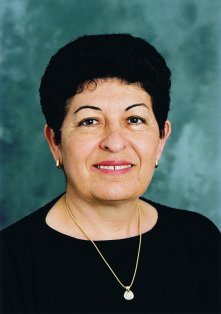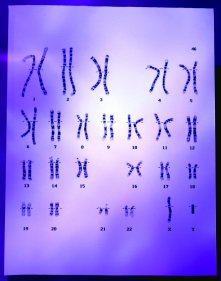In their quest to better understand, prevent, and treat cancer, Weizmann Institute of Science researchers are getting to the heart of the matter by exploring the genetics of the disease.
Prof. Varda Rotter, head of the Institute's Department of Molecular Cell Biology, studies p53, a gene that suppresses tumor growth and may one day open doors to the development of new cancer treatment drugs. "There is really a strong feeling that a critical breakthrough in preventing cancer and designing future therapies will occur once it is understood how this gene works," said Prof. Rotter.
With the mapping of the human genome, knowledge of p53 is expanding: both biology and genetics as a whole have, in the past six years, undergone a major revolution. Prof. Rotter went on to explain that p53 is a very important gene and one of the major tumor suppressors in our genome.

She elaborated that the human genome is comprised of some 30,000 genes, which are present in each individual human cell. The beauty of biology is that each healthy cell can only "read" a certain part of the genome. For example, our skin cells can interpret the information needed to produce melanin and protect us from the sun, while ovarian cells will read enough information to know to secrete hormones in a coordinated way at a given time.
While healthy cells carry out their intended functions, researchers are asking themselves how cancer cells differ. For molecular biologists, understanding the unique features of the cancer cell is critical for recognizing the enemy.
A cancer cell, while similar to a normal cell, not only reads and translates genes at the wrong time and place, but also contains mutated genes, Prof. Rotter stated. Contributing to malignancy are oncogenes, which under certain conditions turn a normal cell into a cancerous one. "There is no simple answer as to why we carry oncogenes," she said.
There about 150 oncogenes, all of which are supposed to be silent, explained Prof. Rotter, but certain incidents or accidents provoke the cells to start growing or multiplying in an uncontrolled way. In contrast, healthy cells know how to grow and reproduce themselves to a certain degree and then stop.
At least 300 mechanisms can awaken oncogenes, said Prof. Rotter. The most common is the occurrence of a genetic mutation which, although not necessarily inherited, can be passed down from parent to child. Environmental factors, such as exposure to too much ultraviolet light or x-rays, can also awaken an oncogene. Once a mutation in a dormant oncogene occurs and becomes functional, it cannot be turned off.
"Our cells knew about the problem of oncogene ‘awakening' long before it was discovered by us," she said. Healthy cells, having this knowledge, contain tumor suppressor genes such as p53 that fight oncogenes by scanning for genetic mistakes and signaling cells to repair the damage or stop replicating, and thus helping to prevent uncontrolled proliferation. Genes such as p53 also initiate cell death: a healthy cell knows when to die, noted Prof. Rotter.
Researchers have found that many cancer cells do not contain healthy tumor suppressor genes. These genes are instead mutated and cannot execute their functions. They do not know how to sense damaged DNA or how to put repair or cell death into motion, she said.
"Some people are born with less-than-perfect tumor suppressor genes — that's the concept of genetic predisposition to cancer," said Prof. Rotter. "A parent can have a mutation in the p53 gene and can transmit it to his or her children."

While p53's role as a single gene is important, knowing how it interacts with the rest of the genome is crucial to understanding cancer development, Prof. Rotter said. "Cancer growth is not mediated by a single gene. Rather, it involves a multitude of genes," she added.
To better understand how p53 prevents cancer, Prof. Rotter and her colleagues developed a system that makes it possible to change the status of the tumor suppressor gene in a controlled way at specific and defined stages of cancer development. They then analyzed how other genes expressed themselves at given time points in relation to p53 status using "gene chips," which are small glass slides containing microscopic strips of DNA. One chip provides a printout of activity levels of about 10,000 genes, allowing researchers to observe which genes are involved at a given time point in the cancer's development.
A group of physicists from the Weizmann Institute have developed computational tools in order to help the researchers make sense of the genes' activity on these chips. These tools have enabled Prof. Rotter and her colleagues to identify ten clusters of genes that are altered in the course of cancer development. They found one group to be negatively regulated by p53 — a discovery that would have been impossible without the new computational tools, explained Prof. Rotter. "It's like putting a new lens in your glasses and being able to see everything in an additional dimension," she said.
Understanding how a network of genes is affected by p53 may lead to the development of therapies that target these entire genetic pathways rather than just one specific gene. "We hope to one day develop therapies that will target specific networks of genes," Prof. Rotter said. "Continued research of p53 and defining its role in preventing cancer growth is a fantastic challenge."
Prof. Varda Rotter's research is supported by the Women's Health Research Center; the Flight Attendant Medical Research Institute; the Mario Negri-Weizmann Scientific Collaboration; the Ridgefield Foundation; and the Shepard Broad Foundation. Prof. Rotter is the incumbent of the Norman and Helen Asher Chair of Cancer Research. The Weizmann Institute of Science in Rehovot, Israel, is one of the world's foremost centers of scientific research and graduate study.The American Committee for the Weizmann Institute of Science is a community of dedicated people who share a common vision in support of the Institute. The generous assistance the Weizmann Institute receives from individuals, foundations, and corporations is vital for its future. Committee members show their devotion to the advancement of the Institute's goals by becoming partners in the search for answers to the most difficult challenges facing humanity.
